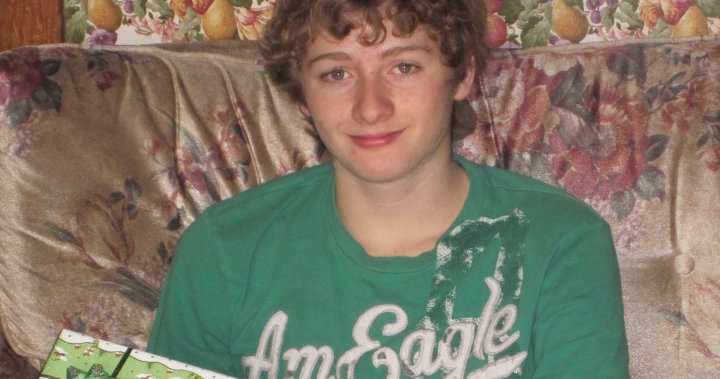Brock Ruether was a seemingly perfectly healthy teenager, athletic, friendly and outgoing. He loved dirt biking and playing the board game Risk.
In May 2012, the 16-year-old from Fairview, Alta., was at a high school volleyball practice when he collapsed to the ground from cardiac arrest. His heart had stopped beating.
An ambulance was called and CPR started within minutes. But it was not enough to save him. The one item that may have saved his life, an automated external defibrillator (AED), was right next to him but never used.
“Despite the availability of the AED, nobody was trained to get it or recognize that this was a sudden cardiac arrest emergency,” Kim Ruether, Brock’s mother, told Global News.
“They retrieved it and put it beside him, but they never used it. And so that was a big part of his demise, which again, no blame, but it’s a tragic reality that he went from an enormous chance of survival to zero in the 15 minutes that he laid on the gym floor.”
Brock Ruether (back left) and his family.
Kim Ruether
That’s because when it comes to out-of-hospital cardiac arrest — like what happened with Brock — every second counts and fast action can save a life. Immediate CPR keeps the blood pumping to keep the brain and other vital organs alive and an AED will shock the heart to help it restart, according to the Heart and Stroke Foundation. Survival drops significantly every minute without these life-saving measures.
“I wish people realized that sudden cardiac arrest can affect anyone at any age, and there are a multitude of children and young adults that have cardiac arrests every year,” Kim said. “What I also wish people knew is that a simple CPR class goes so far in teaching you how easy it is to do CPR and use an AED. An AED is easier to use than your cellphone.”
‘One in 10 people will survive’
Every nine minutes a Canadian suffers a cardiac arrest outside hospitals and only one in 10 people will survive, according to a report released Thursday by the Heart and Stroke Foundation.
The report, called Every second counts: Transforming resuscitation to restart more hearts, found that the number of cardiac arrests in Canada is significantly higher than previously estimated.
“We used to estimate the affected 40,000 people annually in Canada. And now our closest estimates, more accurately, would say 60,000 cardiac arrests are happening each year,” said Dr. Christian Vaillancourt, a professor of emergency medicine at the University of Ottawa.
“To put things in perspective, if you’re going to be watching the Super Bowl, that’s as many people as usually attend the Super Bowl in the arena.”
The data from the report also found that nearly half of cardiac arrests happen to people under the age of 65.
The causes of cardiac arrest include coronary heart disease, a heart attack, congenital heart disease, electrocution, drowning, choking, respiratory distress and recreational drug use, according to the Heart and Stroke Foundation.

“It’s important to clear these misconceptions when you think about a cardiac arrest and getting CPR training, most people think it’s going to be on an older person, and it couldn’t be further from the truth. It’s true that a good proportion of cardiac arrests, if you look at the average age, it may be 68 years old, for example, but half of the victims of cardiac arrests are younger than that,” Vaillancourt explained.
Cardiac arrest can affect anybody, he stressed, adding that half of the people who suffer a sudden cardiac arrest have never had any symptoms of anything wrong with them before, or cardiac disease or symptoms to begin with.
Get the latest Health IQ news.
Sent to your email, every week.
“And most often it will be at home. Eighty per cent of cardiac arrests or more happen in your own home, and it’s not going to be a stranger. It’s going to be a loved one,” he added.
Cardiac arrest verses heart attack
There is a key difference between a cardiac arrest and a heart attack.
Cardiac arrest means the heart has stopped beating, explained Vaillancourt.
A heart attack involves a blockage in one of the heart’s vessels, he said. During a heart attack, most people remain conscious and typically experience severe chest pain. They are also usually awake and alert enough to seek medical help, and around “90 per cent of them survive.”
“A cardiac arrest is very different in that people are essentially dead, but they are able to be resuscitated,” he said. “So in cardiac arrest, your heart has stopped functioning normally, you lose consciousness. You may have a few occasional gasps or signs of life, but this is not really someone who is alive.”
Given the Heart and Stroke Foundation’s report finding a one in 10 survival rate for out-of-hospital cardiac arrests, Vaillancourt believes sudden cardiac arrest may be one of the highest causes of mortality in Canada.
Despite the high statistics, Vaillancourt noted seeing improvement over recent years and believes that with adequate education on prevention and CPR training, the numbers can continue to significantly improve.
The power of CPR and AEDs
When it comes to cardiac arrest, Vaillancourt stressed that ultimately it always goes back to prevention.
“It’s always better to avoid cardiac arrest than to have to treat it. So healthy choices, good management of chronic diseases like hypertension, diabetes and non-smoking. But what we should strive to have is the entire community population trained in doing CPR,” he said.
When someone experiences cardiac arrest, blood flow to the brain stops, leading to a rapid decline in the chances of survival with each passing minute. That’s why a bystander who performs CPR and uses an AED can “almost double or triple the chances of a victim surviving,” he explained.

Denise Bymak, a resuscitation program manager with the Canadian Heart and Stroke Foundation, said the organization’s goal is to train more people every day.
Last year, she said, the Heart and Stroke Foundation provided CPR and AED training to over half a million Canadians.
“Skills do decay. We can see skills decay as quickly as three months after training. So it is important to retrain, to review your skills, to practice at home, to practice where you can and review any materials,” she told Global News.
There are three simple steps to help someone in cardiac arrest, she said.
- Recognize that someone has suddenly collapsed and they’re unresponsive, not breathing or not breathing normally. Call 9-1-1 and shout for help.
- Start CPR. If you’ve been trained, you must start right away. If you haven’t been trained yet, the 9-1-1 operator will guide you through the steps.
- Use the AED. Shout for someone to bring you an AED. If they bring it, you must use it. That will help restart the heart.
“There’s always that fear of, ‘maybe not doing something right, of hurting that person’,” she said. “And those are those are fears that we’re trying to overcome, that we’re trying to explain to people that really they can only help, that they just can’t hurt this person needs them. Their heart has stopped beating. That’s the definition of cardiac arrest where they’re unresponsive and not breathing.”
‘He had great dreams and great plans’
A few weeks before Brock died, Kim said he was complaining about chest pain.
“It may be completely unrelated, but he was standing in the kitchen, and he was holding his chest and he was saying, ‘You know, mom, my heart hurts’,” she said, adding that it was dismissed as he was so young and she attributed it to something else.
“But looking back, if he would have been 45 or 60, we would have run him into the hospital for tests. And so I think that it was a missed opportunity to diagnose an arrhythmia that ended up fatal,” she said.
Brock would have turned 29-years-old this June and Kim believes her son would have continued to become more extraordinary.
Brock Ruether on his dirt bike.
Kim Ruether
“I think he would have been a delightful person, husband, father and uncle. I think that he had the potential to be such a remarkable human, and he had great dreams and great plans. It’s a tragedy that they weren’t realized,” she said.
After Brock’s death, Kim became a passionate advocate for CPR and AED training. She founded the Project Brock Society, to ensure every school in Alberta is equipped with an AED and people are trained and prepared to take action.
“If we could start training our school kids from kindergarten all the way through and do medical emergency drills, like we do fire drills we could have an entire citizenry trained within a few decades,” she said. “That’s a conversation that really needs to take place in order to boost survival rates.”



